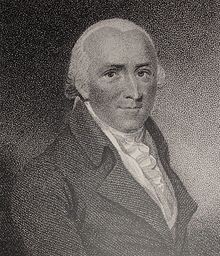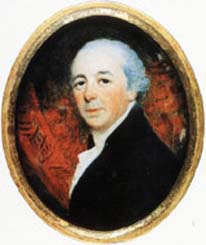
John Nash was one of the foremost British architects of the Georgian and Regency eras, during which he was responsible for the design, in the neoclassical and picturesque styles, of many important areas of London. His designs were financed by the Prince Regent and by the era's most successful property developer, James Burton. Nash also collaborated extensively with Burton's son, Decimus Burton.

Humphry Repton was the last great English landscape designer of the eighteenth century, often regarded as the successor to Capability Brown; he also sowed the seeds of the more intricate and eclectic styles of the 19th century. His first name is often incorrectly rendered "Humphrey".

Powderham Castle is a fortified manor house situated within the parish and former manor of Powderham, within the former hundred of Exminster, Devon, about 6 miles (9.7 km) south of the city of Exeter and 1⁄4 mile (0.4 km) north-east of the village of Kenton, where the main public entrance gates are located. It is a Grade I listed building. The park and gardens are Grade II* listed in the National Register of Historic Parks and Gardens.

The Italianate style was a distinct 19th-century phase in the history of Classical architecture. In the Italianate style, the models and architectural vocabulary of 16th-century Italian Renaissance architecture, which had served as inspiration for both Palladianism and Neoclassicism, were synthesised with picturesque aesthetics. The style of architecture that was thus created, though also characterised as "Neo-Renaissance", was essentially of its own time. "The backward look transforms its object," Siegfried Giedion wrote of historicist architectural styles; "every spectator at every period—at every moment, indeed—inevitably transforms the past according to his own nature."

Prior Park Landscape Garden surrounding the Prior Park estate south of Bath, Somerset, England, was designed in the 18th century by the poet Alexander Pope and the landscape gardener Capability Brown, and is now owned by the National Trust. The garden was influential in defining the style known as the "English landscape garden" in continental Europe. The garden is Grade I listed in the Register of Historic Parks and Gardens of special historic interest in England.
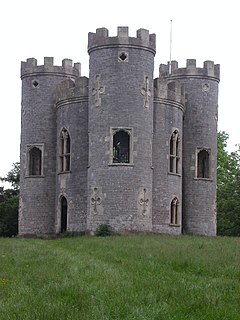
Blaise Castle is a folly built in 1766 near Henbury in Bristol, England. The castle sits within the Blaise Castle Estate, which also includes Blaise Castle House, a Grade II* listed 18th-century mansion house. The folly castle is also Grade II* listed and ancillary buildings including the orangery and dairy also have listings. Along with Blaise Hamlet, a group of nine small cottages around a green built in 1811 for retired employees, and various subsidiary buildings, the parkland is listed Grade II* on the Register of Historic Parks and Gardens of special historic interest in England.

Rattery is located within the county of Devon only a few miles from the villages Buckfastleigh and neighbouring village Ashburton the name can sometime be seen a variant of Red Tree but is mentioned in the Domesday Book as Ratreu. The origins of how it got its name remain unknown but had been many possibles answer put across.

The English landscape garden, also called English landscape park or simply the English garden, is a style of "landscape" garden which emerged in England in the early 18th century, and spread across Europe, replacing the more formal, symmetrical French formal garden which had emerged in the 17th century as the principal gardening style of Europe. The English garden presented an idealized view of nature. Created and pioneered by William Kent and others, the “informal” garden style originated as a revolt against the architectural garden and drew inspiration from paintings of landscapes by Salvator Rosa, Claude Lorrain, and Nicolas Poussin.
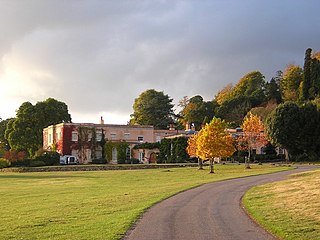
Killerton is an 18th-century house in Broadclyst, Exeter, Devon, England, which, with its hillside garden and estate, has been owned by the National Trust since 1944 and is open to the public. The National Trust displays the house as a comfortable home. On display in the house is a collection of 18th- to 20th-century costumes, originally known as the Paulise de Bush collection, shown in period rooms.
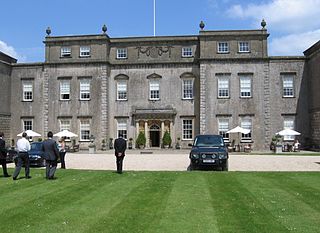
Ston Easton Park is an English country house built in the 18th century. It lies near the village of Ston Easton, Somerset. It is a Grade I listed building and the grounds are listed Grade II on the Register of Historic Parks and Gardens.

Sandridge Park, near Stoke Gabriel, Devon, is an English country house in the Italianate style, designed by John Nash around 1805 for the Dowager Lady Ashburton, née Elizabeth Baring, the wife of John Dunning, 1st Baron Ashburton. It is a Grade II* listed building. By 1822 it was leased to Sir Robert Newman.

Vaucluse House is a heritage-listed residence, colonial farm and country estate and now tourist attraction, house museum and public park located at 69a Wentworth Road, Vaucluse in the Municipality of Woollahra local government area of New South Wales, Australia. Completed between 1803 and 1839 in the Gothic Revival style, its design was attributed to William Charles Wentworth and built by Sir Henry Browne Hayes and W. C. Wentworth. The property is owned by the Historic Houses Trust of New South Wales, an agency of the Government of New South Wales. The site was added to the New South Wales State Heritage Register on 2 April 1999.
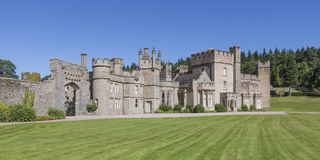
Stanage Park is a Grade II* listed Welsh country house set in a large park located some 3 miles (4.8 km) east of Knighton, Powys near the settlement of Heartsease. The extensive parkland and the house were laid out by Humphry Repton and his son, John Adey Repton, in the early nineteenth century. Repton's picturesque parkland improvements, castellated house and enclosed garden survive almost intact. The estate is the last and most complete of his three recognized Welsh landscape commissions.

The Haldon Hills, usually known simply as Haldon, is a ridge of high ground in Devon, England. It is situated between the River Exe and the River Teign and runs northwards from Teignmouth, on the coast, for about 24 km (15 mi) until it dwindles away north west of Exeter at the River Yeo, just south of Crediton. The highest points of just over 250 metres (820 ft) lie to the south west of Exeter. The southernmost part is known as Little Haldon; it is partially separated from the main bulk of the hills by a col formed by the valleys of the Dawlish Water to the east and the valley at Rixdale to the west.

Mamhead is a rural village and civil parish near Dawlish and Kenton in Devon, South West England, in the Teignbridge local authority area. Current community venues include Mamhead Village Hall and The Church of England parish church, dedicated to St Thomas the Apostle,
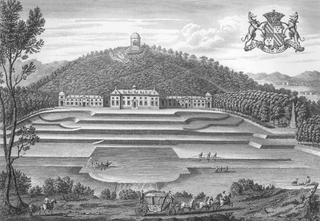
Castle Hill in the parish of Filleigh in North Devon, is an early Neo-Palladian country house situated 3 miles north-west of South Molton and 8 mi (13 km) south-east of Barnstaple. It was built in 1730 by Hugh Fortescue, 14th Baron Clinton (1696–1751), who was later created in 1751 1st Baron Fortescue and 1st Earl of Clinton, the son of Hugh Fortescue, lord of the manor of Filleigh, Weare Giffard, etc., whose family is earliest recorded as residing in the 12th century at the manor of Whympston in the parish of Modbury in South Devon. The Fortescue family became major land owners, influential in British and West Country history. Castle Hill is a rare example in Devon of an 18th-century country mansion "on the grand scale".

Endsleigh Cottage is a country house near Milton Abbot, about 6 miles NW of Tavistock, Devon in England. It is a Grade I listed building. The gardens are Grade I listed in the National Register of Historic Parks and Gardens. The house was built in the early 19th century for the Duke of Bedford. Today, it is a hotel.
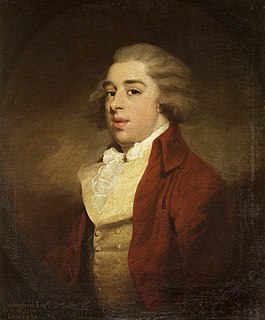
Charles Hoare was Senior Partner of the banking firm of C. Hoare & Co
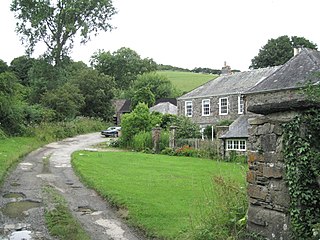
Luscombe is an historic estate situated in the parish of Rattery in Devon.

Mamhead House, Mamhead, Devon, is a country house dating from 1827. Its origins are older but the present building was constructed for Robert William Newman, an Exeter merchant, in 1827–1833 by Anthony Salvin. The house is Grade I listed. The parkland has its own Grade II* listing. It was for a time known as Dawlish College.





